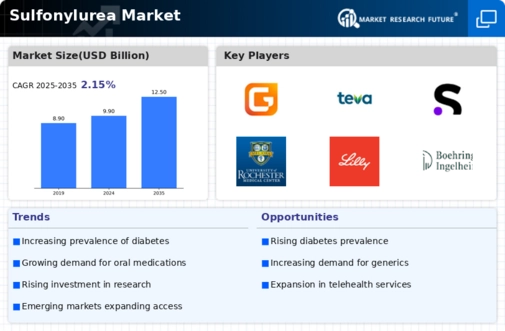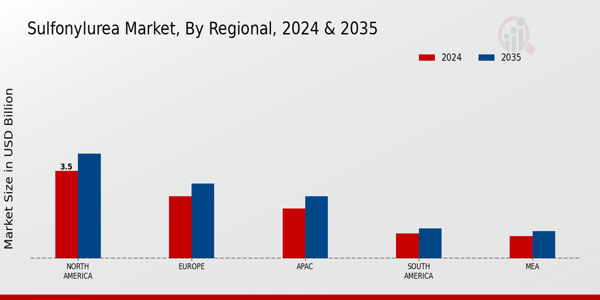Market Growth Projections
The Global Sulfonylurea Market Industry is projected to experience steady growth over the coming years. With a market value of 9.9 USD Billion in 2024, it is expected to reach 12.5 USD Billion by 2035. This growth trajectory indicates a compound annual growth rate of 2.14% from 2025 to 2035. Factors contributing to this growth include the rising prevalence of diabetes, advancements in drug formulations, and increasing awareness of diabetes management. As the market evolves, it will likely adapt to changing healthcare needs and patient preferences, ensuring its relevance in the global healthcare landscape.
Rising Prevalence of Diabetes
The increasing incidence of diabetes globally is a primary driver for the Global Sulfonylurea Market Industry. As per recent statistics, diabetes affects over 463 million adults worldwide, a number projected to rise significantly. This surge in diabetes cases necessitates effective treatment options, with sulfonylureas being a widely prescribed class of medications. In 2024, the market is valued at approximately 9.9 USD Billion, reflecting the growing demand for antidiabetic drugs. The need for accessible and effective diabetes management solutions is likely to bolster the market further, as healthcare systems strive to address this escalating health crisis.
Growing Awareness and Education
Enhanced awareness and education regarding diabetes management are pivotal in driving the Global Sulfonylurea Market Industry. Public health campaigns and educational initiatives are informing patients and healthcare providers about the importance of effective diabetes control. As individuals become more knowledgeable about treatment options, the demand for sulfonylureas is likely to increase. This growing awareness is expected to translate into higher prescription rates, further propelling market growth. The emphasis on patient education and self-management strategies is anticipated to play a significant role in shaping the market landscape over the next decade.
Increasing Geriatric Population
The global demographic shift towards an aging population is significantly impacting the Global Sulfonylurea Market Industry. Older adults are at a higher risk of developing type 2 diabetes, leading to increased prescriptions of sulfonylureas. As the geriatric population continues to expand, healthcare providers are likely to prioritize effective management of diabetes in this demographic. This trend is reflected in the market's projected growth, with a compound annual growth rate of 2.14% anticipated from 2025 to 2035. The need for tailored diabetes management solutions for older patients is expected to drive demand for sulfonylureas in the coming years.
Advancements in Drug Formulations
Innovations in drug formulations and delivery systems are enhancing the efficacy of sulfonylureas, thereby driving the Global Sulfonylurea Market Industry. Recent developments have led to the introduction of novel formulations that improve patient compliance and therapeutic outcomes. For instance, extended-release formulations allow for once-daily dosing, which is more convenient for patients. These advancements not only improve the overall management of diabetes but also contribute to the market's growth trajectory. As the industry evolves, the market is expected to reach 12.5 USD Billion by 2035, indicating a sustained interest in improved sulfonylurea products.
Cost-Effectiveness of Sulfonylureas
Sulfonylureas are often regarded as cost-effective treatment options for diabetes management, which is a crucial factor driving the Global Sulfonylurea Market Industry. Compared to newer classes of antidiabetic medications, sulfonylureas typically have lower costs, making them accessible to a broader patient population. This affordability is particularly important in low- and middle-income countries, where healthcare budgets may be constrained. As healthcare systems increasingly seek to optimize costs while ensuring effective diabetes management, the demand for sulfonylureas is likely to remain robust. This trend supports the market's growth, contributing to an estimated value of 9.9 USD Billion in 2024.















